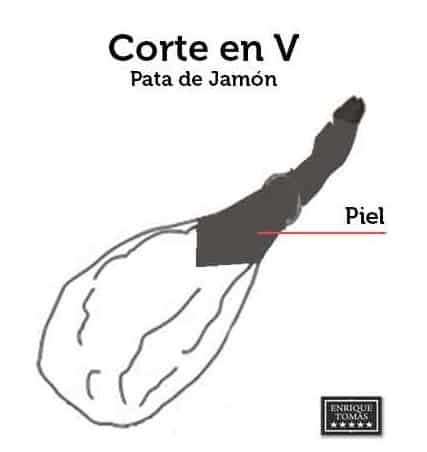
Why is ham cured with salt?
Iberian ham is the star product of Spanish gastronomy, and although we all love to enjoy its flavor at any time, it's not entirely clear to us why ham is cured with salt. But, do you want to discover it?
At Enrique Tomás, we are going to explain it to you because, in addition to marketing the best Iberian ham... We want to be ambassadors of all the culture that surrounds it!
Curing of Ham
In the past, to extend the shelf life of hams after they were cut into pieces, the legs were buried in salt and cured, and that's how the salting and drying process was born.
Salting is the name given to the preservation method by which hams are dehydrated with salt, burying them in this mineral to enhance their flavor and prevent bacterial action.
Before starting the process, a V-shaped cut is made on the hams to allow the mineral to penetrate better and accentuate the flavors and nuances. However, this cut is not made on all pieces, and the Huelva shoulder hams are the exception that proves the rule.

V-cut Illustration of a Ham Leg
That said, once done, the hams are stacked on top of each other in containers, with no more than five layers of legs, and they are buried in salt, alternating a row of meat and a row of salt. Then, they are left for two or three days, and the container is turned upside down so that the salt falls on the opposite side of the hams, salting them on both sides. This process is repeated again and again until the legs have spent about two weeks in this mineral, at which point they are removed and washed with warm water.
 Salt Curing Process for Hams
Salt Curing Process for Hams
When rinsing them, the salt adhering to the outside is removed, leaving only the salt absorbed inside the piece. Afterward, the molding, profiling, and refining of the ham are performed to improve its morphological characteristics – as they have been stacked on top of each other – and the next phase of the ham curing process continues.
How is this process done today?
Today, unlike in the past, the salting process is mechanical, and the containers are automatically turned, making it easier to flip them, saving time, and ensuring uniform salting. Depending on the salting and drying process followed by master artisans, the pieces will have different flavors. For example, producers in Salamanca hang the legs for a longer time than other master artisans, resulting in the milder flavor of the famous Guijuelo ham. This is just one example, but as the saying goes, every master has their own way.
 Process for the Curing of Iberian Ham
Process for the Curing of Iberian Ham
The ham artisans, as we like to call them at Enrique Tomás, decide what flavor they want to give to the pieces before starting, and for this, they have all the information they need: the breed of pig from which the pieces come, their diet, or the fat content, among other data. Based on this, they will decide what taste they want each ham to have and what to do to achieve it.
As you can see, this process is much more complex than it seems, and now that you know why ham is cured with salt and the work needed to achieve it, Don't think twice and make sure to buy a top-quality piece obtained from authentic pigs and cured as it should be!
Now that you have the theory under control, we recommend trying for yourself the different nuances of each curing, according to their taste: mild, aromatic, flavorful, or intense.Find out if you prefer intense or milder flavors.





